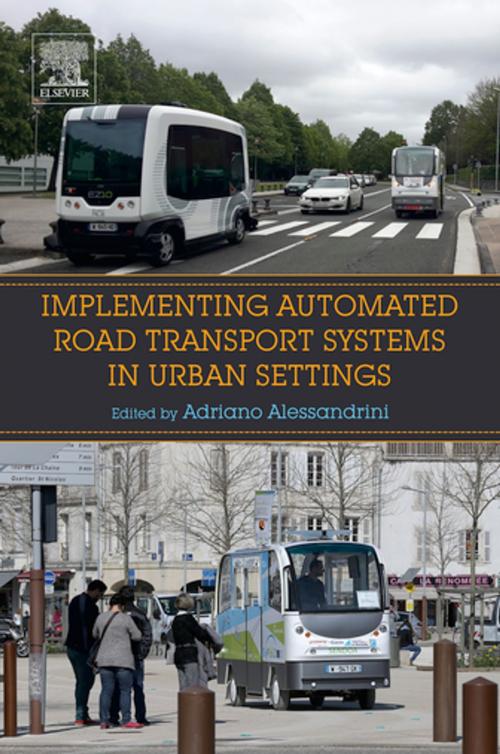Implementing Automated Road Transport Systems in Urban Settings
Nonfiction, Science & Nature, Technology, Social & Cultural Studies, Social Science, Business & Finance| Author: | ISBN: | 9780128129944 | |
| Publisher: | Elsevier Science | Publication: | April 13, 2018 |
| Imprint: | Elsevier | Language: | English |
| Author: | |
| ISBN: | 9780128129944 |
| Publisher: | Elsevier Science |
| Publication: | April 13, 2018 |
| Imprint: | Elsevier |
| Language: | English |
Implementing Automated Road Transport Systems in Urban Settings provides valuable, objective, often difficult-to-obtain data, gleaned from the largest demonstration project on automated road transport systems (ARTS) in the world to date. The book features chapters authored by those deeply involved in CityMobil2—providing an easily accessible, cross-referenced resource for data and information on each aspect of the project. Chapters cover vehicle technical specifications, infrastructure analysis, operating systems, future scenario analysis, automated and conventional vehicle comparisons, and legal frameworks for system implementation. The book examines project field tests, showing the technology’s adaptability and different requirements based on geographic location.
Government officials, researchers, and transportation practitioners require real-world data and analysis in their efforts to bring automated and intelligent transport systems into the mainstream. The CityMobil2 demonstration transported more than 60,000 passengers in seven European cities, providing immense amounts of feedback and data to be analyzed. The book provides international expert opinion on this real-world data, highlighting the strengths and weaknesses of the project, as well as providing comparisons to both past and planned ARTS demonstration initiatives. The technical specifications developed from the project will help cities considering similar ARTS initiatives.
- Presents real-world data and valuable analysis from CityMobil2, the world’s largest demonstration project on automated road transport systems (ARTS)
- Assists policy makers seeking to implement their own ARTS, providing technical specifications, infrastructure analysis, as well as legal considerations
- Features a companion website with links to CityMobil2 demonstration videos, as well as links to detailed project documents
- Presents findings from CityMobil2, such as effects on daily trips per capita, average journey distance, and occupancy rate, and how they can affect the development of future ARTS projects
- Provides future ARTS scenario analysis, with information on planned, similar demonstrations
Implementing Automated Road Transport Systems in Urban Settings provides valuable, objective, often difficult-to-obtain data, gleaned from the largest demonstration project on automated road transport systems (ARTS) in the world to date. The book features chapters authored by those deeply involved in CityMobil2—providing an easily accessible, cross-referenced resource for data and information on each aspect of the project. Chapters cover vehicle technical specifications, infrastructure analysis, operating systems, future scenario analysis, automated and conventional vehicle comparisons, and legal frameworks for system implementation. The book examines project field tests, showing the technology’s adaptability and different requirements based on geographic location.
Government officials, researchers, and transportation practitioners require real-world data and analysis in their efforts to bring automated and intelligent transport systems into the mainstream. The CityMobil2 demonstration transported more than 60,000 passengers in seven European cities, providing immense amounts of feedback and data to be analyzed. The book provides international expert opinion on this real-world data, highlighting the strengths and weaknesses of the project, as well as providing comparisons to both past and planned ARTS demonstration initiatives. The technical specifications developed from the project will help cities considering similar ARTS initiatives.
- Presents real-world data and valuable analysis from CityMobil2, the world’s largest demonstration project on automated road transport systems (ARTS)
- Assists policy makers seeking to implement their own ARTS, providing technical specifications, infrastructure analysis, as well as legal considerations
- Features a companion website with links to CityMobil2 demonstration videos, as well as links to detailed project documents
- Presents findings from CityMobil2, such as effects on daily trips per capita, average journey distance, and occupancy rate, and how they can affect the development of future ARTS projects
- Provides future ARTS scenario analysis, with information on planned, similar demonstrations















